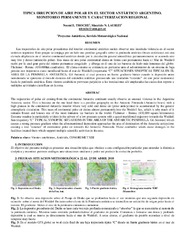Mostrar el registro sencillo del ítem
Típica irrupción de aire polar en el sector antártico argentino: monitoreo permanente y caracterización regional
| dc.contributor.author | Troche, Noemí | |
| dc.contributor.author | Laurizi, Mauricio N. | |
| dc.date.accessioned | 2018-12-05T14:37:28Z | |
| dc.date.available | 2018-12-05T14:37:28Z | |
| dc.date.issued | 2018-10 | |
| dc.identifier.uri | http://hdl.handle.net/20.500.12160/873 | |
| dc.description | Trabajo presentado en el XIII CONGREMET del 16 al 19 de octubre de 2018 en la ciudad de Rosario, Santa Fe, Argentina. | es |
| dc.description.abstract | Las trayectorias de aire polar procedentes del interior continental antártico suelen observar una inusitada violencia en el sector antártico argentino. Esto porque se conjuga por un lado una peculiar geografía sobre la península antártica (bases antárticas) con una elevada altiplanicie en el interior continental antártico donde por la circulación general atmosférica permanentemente se acumula aire muy frío y denso (anticiclón polar). Esta masa de aire polar continental drena en forma casi permanente hacia el Mar de Weddell razón por la cual gran parte del mismo permanece congelado y alberga en él una de las barreras de hielo más inmensas del globo: Flichnner - Ronne. (430.000km cuadrados). El clima extremo se evidencia en particular ante el advenimiento de un sistema de baja presión con trayectoria cuasi meridional hacia el mar de Weddell (trayectoria “C” SITUACIONES SINOPTICAS TIPICAS EN EL AREA DE LA PENINSULA ANTARTICA; Gil Antonio) el cual provoca un fuerte gradiente bárico cuando la depresión antes mencionada se aproxima al área de dominio del anticiclón antártico provocando una verdadera “catarata” de aire polar continental hacia la península antártica. Estos vientos catabáticos provocan perjuicios a las instalaciones allí emplazadas las cuales dan soporte a múltiples actividades científicas en la zona. | es |
| dc.description.abstract | The trajectories of polar air coming from the continental Antarctic continent usually observe an unusual violence in the Argentine Antarctic sector. This is because on the one hand there is a peculiar geography on the Antarctic Peninsula (Antarctic bases) with a high plateau in the continental Antarctic interior where very cold and dense air (polar anticyclone) is accumulated by the general atmospheric circulation. This mass of continental polar air drains almost permanently into the Weddell Sea, which is why much of it remains frozen and houses one of the most immense ice barriers in the world: Flichnner - Ronne. (430,000 square kilometers). Extreme weather is particularly evident in the advent of a low pressure system with a quasi-meridional trajectory towards the Weddell Sea (trajectory "C" TYPICAL SYNOPTIC SITUATIONS IN THE AREA OF THE ANTARCTIC PENINSULA; Gil Antonio) which causes a strong pressure gradient when the aforementioned depression approaches the area of domination of the Antarctic anticyclone causing a true "cataract" of continental polar air towards the Antarctic Peninsula. These catabathic winds cause damages to the facilities located there which support multiple scientific activities in the area. | en |
| dc.language.iso | spa | es |
| dc.publisher | Servicio Meteorológico Nacional. Gerencia de Planificación. Proyectos antárticos. | es |
| dc.subject | VIENTOS CATABÁTICOS | es |
| dc.subject | ANTÁRTIDA | es |
| dc.title | Típica irrupción de aire polar en el sector antártico argentino: monitoreo permanente y caracterización regional | es |
| dc.type | Other | es |
Ficheros en el ítem
Este ítem aparece en la(s) siguiente(s) colección(ones)
-
Resúmenes [113]
